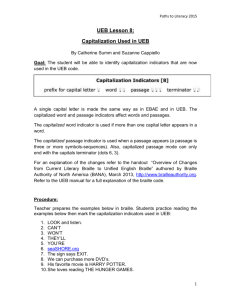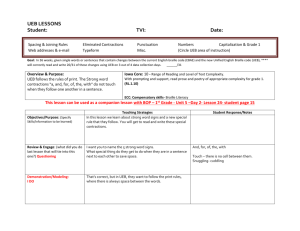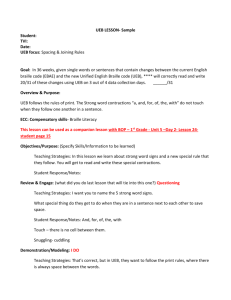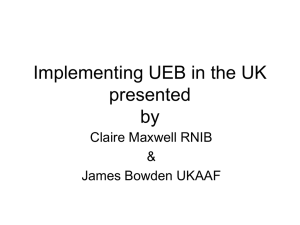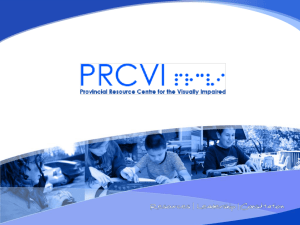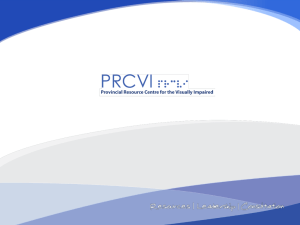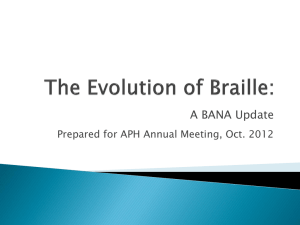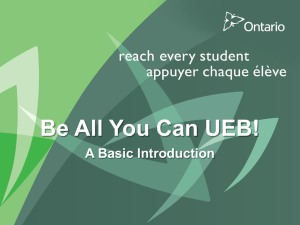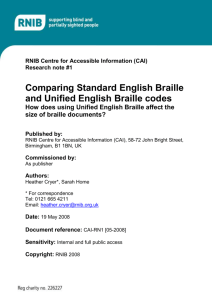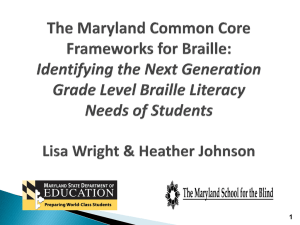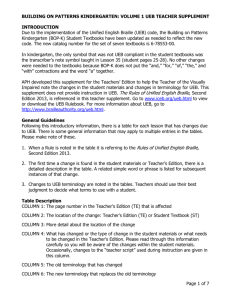Webinar PowerPoint Slides (Word Doc)
advertisement
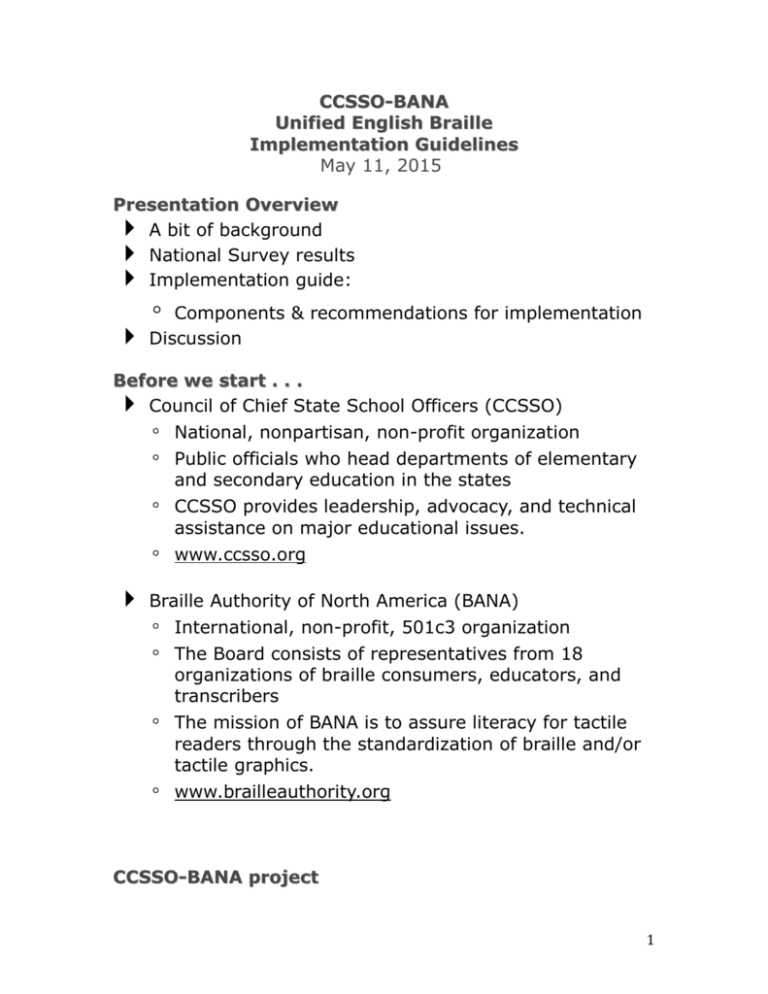
CCSSO-BANA Unified English Braille Implementation Guidelines May 11, 2015 Presentation Overview A bit of background National Survey results Implementation guide: ◦ Components & recommendations for implementation Discussion Before we start . . . Council of Chief State School Officers (CCSSO) ◦ ◦ National, nonpartisan, non-profit organization Public officials who head departments of elementary and secondary education in the states ◦ CCSSO provides leadership, advocacy, and technical assistance on major educational issues. ◦ www.ccsso.org Braille Authority of North America (BANA) ◦ ◦ International, non-profit, 501c3 organization The Board consists of representatives from 18 organizations of braille consumers, educators, and transcribers ◦ The mission of BANA is to assure literacy for tactile readers through the standardization of braille and/or tactile graphics. ◦ www.brailleauthority.org CCSSO-BANA project 1 How this project started: ◦ ◦ ◦ ◦ ◦ Change of braille code from English Braille American Edition (EBAE) to Unified English Braille (UEB). Implementation date is January 4, 2016. BANA has been working with a wide network of national constituents Enormous differences between states for braille procurement, production, and procedures Concern about instructional materials and statewide assessments. CCSSO sought assistance from BANA on behalf of state departments of education & testing consortia. CCSSO-BANA project National Survey Webinars in October and December http://www.ccsso.org/Resources/Programs/Suppor ting_Students_with_Disabilities.html Development of Implementation Guide National Survey Sent to state assessment directors nationwide ◦ Designed to be completed with feedback from team 32 states reported by December 31, 2014 Complete results in the implementation guide Results examined both quantitatively and qualitatively ◦ ◦ ◦ ◦ ◦ Demographics (how many students) Instructional materials Assessment Training of personnel 2 Results used to develop the guide: issues and recommendations Implementation Guide Section 1: Background information Section 2: Issues related to UEB implementation Section 3: Creating state plans for transition: Implications of national survey results Appendix Appendix Appendix Appendix 1: 2: 3: 4: Survey results (detailed) Resources Nemeth-UEB guidance document Sample State Plans Issues related to UEB implementation Code issues ◦ ◦ Mathematics and science transcription Formats Guidelines and other BANA documents Testing issues ◦ ◦ UEB compatible equipment UEB certification from NLS Instructional materials ◦ ◦ Timing Textbook adoption cycles Training issues Level of training Financial issues ◦ Mathematics UEB is a complete, general purpose code; symbols for 3 math are part of the code. It is completely different from Nemeth code. The US voted to keep Nemeth code as an official code along with UEB, a unique position internationally. Some states plan to use UEB solely for “nontechnical” materials and continue to use Nemeth code for math and science. Some states plan to use both UEB and Nemeth for math and science materials. Some states plan to gradually move to UEB for all subjects. Provisional Guidance “Provisional Guidance for Transcription Using the Nemeth Code within UEB Contexts” Use of a code switching symbol for going into and out of Nemeth. Symbol added to UEB Rulebook in 2013. Guidance document on BANA website: ◦ www.brailleauthority.org/ueb.html#nemeth Plan for technical materials “How does your state plan to provide braille textbooks for mathematics and science?” ◦ ◦ ◦ ◦ ◦ ◦ Both UEB and Nemeth = 10 Nemeth only /Nemeth with UEB text = 6 Nemeth for now & revisit = 2 Have not yet determined = 10 Local decision = 3 No response = 1 Other code issues 4 Formats guidelines ◦ Planned revision of Braille Formats: Principles of Print-to-Braille Transcription, 2011 Foreign language textbook transcription guidelines Guidelines and Standards for Tactile Graphics, 2010 Assessment Issues States moving from paper tests to computer-based assessments A complex issue: ◦ ◦ ◦ Refreshable braille devices driven by screen reader translation software with varying amounts of accuracy Proprietary systems that may not work well together: braille device, test platform, browser, etc. Test platform should be designed according to standards, not geared for specific devices Web Content Accessibility Guidelines (WCAG) 2.0, priority AA, found at this website: http://www.w3.org/TR/WCAG20/ Paper or electronic assessments in 2016? Both electronic and paper, depending on the subject and/or test = 11 Paper only = 9 Electronic only = 4 To be determined = 4 Not Applicable = 1 In several cases, the reporting state planned to provide assessments using a combination of methods. 5 Assessment and Instruction Plan for 2017 and beyond Students need practice materials so they are tested on content and not accuracy with specific devices. Assessments should measure the instruction that has been provided in the state standards, and should be in the same code(s). It takes time and training to create well-designed braille assessments and instructional materials. 13 states plan to start providing textbooks in UEB by end of 2015, with another 13 during 2016. No response or not yet determined = 6 Training More than half of states reported that they require NLS certification for braille transcribers who produce assessments, or that it’s their general practice At the time of the survey, most states had not started training transcribers in UEB, but had started training teachers. Creating state plans for transition Component 1: Create a UEB Implementation Committee Component 2: Create a Timeline for Implementation Component 3: Training of Educators and Transcribers Component 4: Addressing procurement and infrastructure issues Component 5: Communication Create UEB Implementation Committee Include wide representation from varied constituents Bottom-up and top-down interactions Frequent meetings Open discussion 6 Development of state plans that fit the capacities and resources in that state. State plans being collected on the BANA web site Fluidity in plans to meet changing needs Create a timeline Develop timeline based on state capacity and other procurement issues Consider both instructional materials and assessments. Implement by grade level: K-2 or K-3, then work up from there. A few states implementing UEB related to textbook adoption cycles. Use of planning tools. Braille Assessments Address on students’ IEPs. Assessments will need to be prepared in more than one code during implementation phase. Assessments offered in more than one format. Share resources between districts and between states. Survey districts within the state to ascertain readiness for testing requirements. Training in UEB Face-to-face training opportunities Distance learning opportunities PR eService teacher training materials Teacher certification/licensure NLS certification for braille transcribers Reference materials and resources for other stakeholders Infrastructure 7 Based on feedback from the survey and from the BANA UEB Transition Forum: ◦ ◦ ◦ ◦ ◦ Request forms updated to include UEB Update databases of braille materials to include UEB as an option Update internal student databases for code use Update IEP forms to include UEB Maintain a list of UEB compatible devices and software Communication BANA organization publications and web sites Parents and students Administrators and special education supervisors Classroom teachers IEP teams Paraprofessionals Appendices Appendix 1: Survey results Appendix 2: Resources Appendix 3: Nemeth-UEB guidance document Appendix 4: Sample State plans What does this mean for students reading braille? States are in various stages of readiness to make the transition. Some states are starting with youngest grades first, others are not. Braille transcribers will need training in UEB as well as educators. Many technology devices are equipped for UEB; some 8 are not yet very accurate. May mean multiple braille forms of same statewide assessment. Summary An exciting and busy time: ◦ ◦ ◦ States working together and sharing Development of new braille training tools More conversations about instructional strategies for STEM academic areas ◦ Opportunity for more braille research Moving together toward the same goal but with customized timelines. Renewed interest in braille literacy! Contact Us Braille Authority of North America www.brailleauthority.org Join the BANA-Announce list on the web site Frances Mary D’Andrea, Chair, UEB Transition Task Force, and Immediate Past-Chair, BANA literacy2@mindspring.com 9
